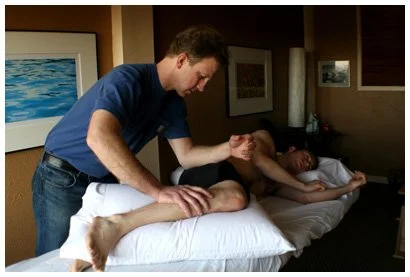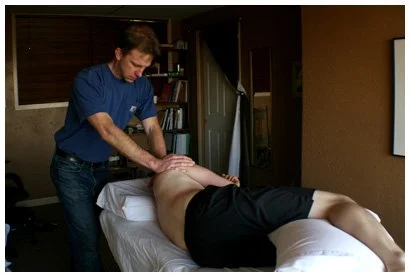Rolfing®, also called structural integration, is a form of bodywork developed over 50 years of study and practice by Dr. Ida Rolf, a biochemist.
The main goal of Rolfing is to help you move better and feel better. After a successful session of Rolfing, you will feel lighter, move easier, stand taller, and often feel less pain.
Rolfing Relieves Excess Stress and Tension
Most of my clients are seeking relief from pain or stiffness in the neck, shoulders, between the shoulder blades, the low back, or the lower legs. Your body can start to feel this way when it is unnecessarily tense. Movement becomes limited and stiff. Even simple activities like sitting, sleeping and breathing can feel restricted, uncomfortable, and heavy.
Rolfing can relieve excess tension in the body and make movement, posture and breathing feel easier and lighter. This is done by making changes to the muscles, connective tissue (called fascia) and the central nervous system. The result is more efficient and comfortable movement and a greater sense of physical well being.
Rolfing Doesn’t Hurt
Many of my clients will remark after the first session,
“That felt great. I thought this was supposed to hurt?!”
Rolfing gained a reputation for being painful in the 1970s because of the way it was practiced in that era. But things have changed. Please know that I do not want to cause my clients any pain during a session. There can be moments in our work together when a client may experience an intensity that some people might describe as a “good pain” that comes from deep pressure in the right spot, but I encourage communication throughout the session to know if the pressure needs adjustment.
Rolfing Addresses the Whole Body Because Everything is Connected
Rolfing is distinct from many other forms of massage in that it takes a global approach to understanding and treating movement and pain issues. For example, if you have pain in your knee, this is not necessarily the “fault” of the knee. Instead, the knee may be suffering because of movement restrictions in the foot, ankle, hip, or even opposite shoulder. In other words, Rolfers look at pain or dysfunction in a particular area as a sign of imbalance in the whole system, rather than a problem in that particular area.
Who Gets Rolfing?
Rolfing is for anyone who wants to improve the way they feel and move. Although it can be used to treat a specific condition, it is also generally beneficial thing to do, like getting a good night’s sleep, exercising, or eating a nutritious meal. It is estimated that more than 1 million people have received Rolfing work, including professional athletes from the NFL and NBA, dancers, martial artists, and many people who sit behind computers all day.
What to Expect
At your first session we discuss your health history, your goals and expectations for Rolfing. I also address any questions you may have.
At the beginning of the session, I will evaluate your structure, both standing and walking. In order to evaluate body structures, I work with people in their underwear (and tops for women). You may also wear running shorts and a sports bra or a light T-shirt if you would be more comfortable. I am dedicated to your feeling as safe as possible.
After I make some structural assessments, you will lie on the padded table, and we will work together to bring awareness to areas of holding and work to release these holding patterns. A large part of my work is also helping you bring awareness to your holding patterns and finding alternatives that will offer you more ease.
I would be happy to answer any other questions you have about Rolfing and whether it can help you achieve your goals.


